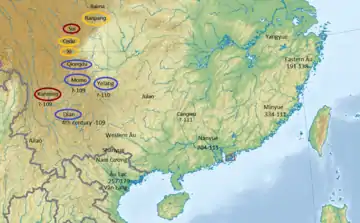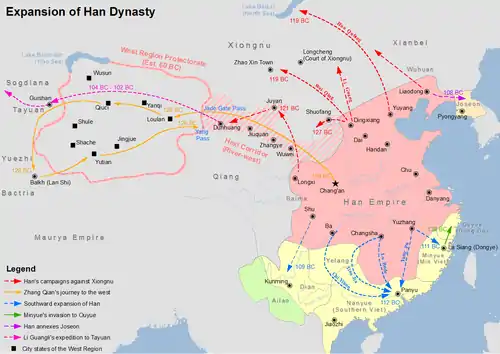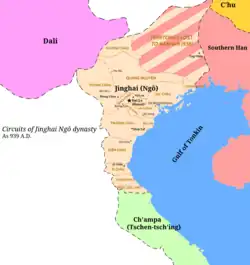Timeline of Vietnam under Chinese rule
This is a timeline of Vietnamese history under Chinese rule from the 3rd century BC to 905.
3rd century BC
| Year | Date | Event |
|---|---|---|
| 257 BC | Thục Phán of the Âu Việt invades Văn Lang and creates Âu Lạc[1] | |
| 207 BC | Qin general Zhao Tuo captures the Cổ Loa Citadel and defeats Âu Lạc, creating the two administrative regions of Jiaozhi (Giao Chỉ) and Jiuzhen (Cửu Chân)[1] | |
| 203 BC | Zhao Tuo declares himself king of Nanyue (Nam Việt)[1] | |
2nd century BC
| Year | Date | Event |
|---|---|---|
| 198 BC | Two legates are assigned to oversee affairs in Jiaozhi and Jiuzhen[2] | |
| 181 BC | Nanyue attacks Changsha[3] | |
| 111 BC | Han conquest of Nanyue: Han general Lu Bode conquers Nanyue and separates it into Jiaozhi, Jiuzhen, Cangwu, Nanhai, Yulin, Hepu, Dan'er, and Zhuya.[4] Starts First Era of Northern Domination.[5] |
1st century
| Year | Date | Event |
|---|---|---|
| 2 | Census records for Jiaozhi, Jiuzhen, and Rinan record 143,643 households and a population of 981,755[6] | |
| 40 | Trung sisters' rebellion: Yue tribes rebel in Jiaozhi[7] | |
| 42 | Trung sisters' rebellion: Ma Yuan leads an expedition to Jiaozhi[8] | |
| 43 | Trung sisters' rebellion: The Trưng Sisters are decapitated[7] |
2nd century
| Year | Date | Event |
|---|---|---|
| 100 | A rebellion in Jiaozhi is put down[9] | |
| 136 | People known as the Qulian from beyond the southern frontier attack Rinan Commandery, causing turmoil and confusion[10] | |
| 137 | Rinan rebels[9] | |
| 144 | Rinan rebels[9] | |
| 157 | Chu Đạt rebels in Jiuzhen Commandery and is defeated[11] | |
| 160 | Shi Ci becomes administrator of Rinan[9] | |
| 190 | Shi Ci's son Shi Xie appoints his brothers Shi Yi, Shi Wei, and Shi Wu as administrators of Hepu, Jiuzhen, and Nanhai[12] | |
| 192 | The southernmost district of Rinan Commandery, Xianglin, breaks away and becomes the Kingdom of Lâm Ấp, otherwise known as Champa[13] |
3rd century
| Year | Date | Event |
|---|---|---|
| 211 | Shi Xie submits to Sun Quan's overlordship[12] | |
| 217 | Shi Xie sends his son Shi Xin to Sun Quan as hostage[12] | |
| 226 | Shi Xie dies and Sun Quan's general Lü Dai kills his family;[12] Shi Xie, also called Sĩ Nhiếp in Vietnamese, is remembered today in Vietnam as the father of education and Buddhism - according to Stephen O'Harrow, he was essentially "the first Vietnamese"[14] | |
| 248 | Lâm Ấp (probably Champa) seizes Rinan while Lady Triệu rebels unsuccessfully against Sun Wu[14] |
4th century
| Year | Date | Event |
|---|---|---|
| 347 | Lâm Ấp invades Jiaozhi but is repulsed by the Jin dynasty (266–420)[15] | |
| 359 | Lâm Ấp is defeated[15] | |
| 377 | Li Xun seizes Jiuzhen[15] | |
| 380 | Teng Dunzhi becomes governor of Jiaozhi after Du Yuan kills Li Xun[15] | |
| 399 | Du Yuan becomes governor of Jiaozhi and defeats a Lâm Ấp invasion[15] |
5th century
| Year | Date | Event |
|---|---|---|
| 405 | Lâm Ấp attacks Jiaozhi[16] | |
| 410 | Du Yuan dies and is succeeded by Du Huidu[15] | |
| 411 | A rebel army under Lu Xun attempts to seize control over Jiaozhi but fails[17] | |
| 413 | Lâm Ấp attacks Jiaozhi[16] | |
| 415 | Lâm Ấp attacks Jiaozhi[16] | |
| 423 | Du Huidu dies and is succeeded by Du Hongwen[15] | |
| 424 | Lâm Ấp attacks Jiaozhi[16] | |
| 427 | Du Hongwen leaves Jiaozhi for the court after receiving an appointment[15] | |
| 443 | Tan Hezhi, governor of Jiaozhi, starts recruiting an army[18] | |
| 446 | Tan Hezhi invades Lâm Ấp and pushes them back to the area around modern Da Nang[18] | |
| 468 | Two brothers Lý Trường Nhân and Lý Thúc Hiến rebel against the Liu Song dynasty, emperor Emperor Ming of Song de jure recognizes Lý Trường Nhân as Thứ sử (province governor, cishi)[19] | |
| 485 | Lý Thúc Hiến surrenders to Qi Dynasty[20] |
6th century
| Year | Date | Event |
|---|---|---|
| 541 | Lý Bôn (503–548) rebels and attacks Liang officials[21] | |
| 544 | February | Lý Bôn establishes the Early Lý dynasty (Kingdom of Vạn Xuân) and becomes Lý Nam Đế (Southern Emperor)[22] |
| 545 | Chen Baxian drives Lý Nam Đế into the mountains, where he is eventually killed, but resistance continues under Lý Thiên Bảo[22] |
7th century
| Year | Date | Event |
|---|---|---|
| 602 | Sui–Former Lý War: Sui forces under Liu Fang annex the kingdom of Vạn Xuân[23] | |
| 618 | Transition from Sui to Tang: Sui military leaders in Jiaozhou follow Xiao Xian fight against the new Tang Empire[24] | |
| 622 | Transition from Sui to Tang: Li Yuan and his forces defeat Xiao Xian, then arrive Tống Bình (Hanoi). Jiaozhou governor Khâu Hòa (552–637) surrenders to Tang dynasty. Jiaozhou is incorporated into Tang Empire[25] | |
| 679 | Jiaozhi is renamed Annan (An Nam)[26] | |
| 687 | Lý Tự Tiên and Đinh Kiến revolt at Đại La in response to a raise in harvest tax[27] | |
| 691 | I-ching's book Commentary about Monks of the Great Tang mentions 6 Vietnamese Buddhist monks who traveled to India |
8th century
| Year | Date | Event |
|---|---|---|
| 722 | Mai Thúc Loan rebels in Annan and is defeated[28] | |
| 767 | Srivijaya fleets invade Annan and are defeated[28] | |
| 785 | Phùng Hưng rebels in Annan[29] | |
| 791 | Tang regains control of Annan[29] |
9th century
| Year | Date | Event |
|---|---|---|
| 803 | Champa seizes southern Annan[30] | |
| 846 | Nanzhao raids Annan[30] | |
| 858 | Rebellion breaks out in Annan and is put down[31] | |
| 861 | Nanzhao attacks Bo Prefecture and Annan but is repulsed.[32] | |
| 863 | Nanzhao conquers Annan[33] | |
| 866 | Gao Pian retakes Annan from Nanzhao and establishes the Jinghai Army (Military Command)[33] | |
| 874 | Tang dynasty launches a campaign against aboriginal forces[34] | |
| 877 | Troops deployed from Annan rebel in Guangxi[34] | |
| 879 | Campaign against aboriginal forces ends[34] | |
| 880 | A Tang garrison at Đại La mutinies, forcing Zeng Gun to withdraw troops from the south and relinquish control over Annan; ending de facto Chinese control over Vietnam[35] |
10th century
| Year | Date | Event |
|---|---|---|
| 904 | Zhu Wen's brother Quanyu tries to enter Annan but is immediately dismissed the next year for being "stupid and without ability"[36] | |
| 906 | Khúc Thừa Dụ of the Khúc clan takes control of Annan and establishes tributary relations with Later Liang[35] |
Gallery
 Yue/Viet tribes pre-Han conquest
Yue/Viet tribes pre-Han conquest Han conquest of Nanyue in 112 BC
Han conquest of Nanyue in 112 BC Ngô dynasty in 938
Ngô dynasty in 938
See also
- Annam (province) (Annan)
- Tĩnh Hải quân (Jinghai Jun)
- Timeline of the Lý dynasty
Citations
- Taylor 2013, p. 14-16.
- Taylor 2013, p. 17.
- Twitchett 2008, p. 136.
- Twitchett 2008, p. 453.
- Chua 2018, p. 43.
- Taylor 2013, p. 18.
- Twitchett 2008, p. 271.
- Taylor 2013, p. 22.
- Taylor 2013, p. 27.
- Taylor 1983, p. 48.
- Taylor 1983, p. 50.
- Crespigny 2007, p. 739.
- Taylor 1983, p. 47.
- Taylor 2013, p. 29.
- Taylor 2013, p. 31.
- Taylor 2013, p. 32.
- Taylor 2013, p. 23.
- Taylor 2013, p. 33.
- Book of Qi, vol. 2, p. 6
- Book of Qi, vol. 58, p. 14
- Taylor 2013, p. 34.
- Taylor 2013, p. 35.
- Taylor 2013.
- Old Book of Tang, vol. 59
- New Book of Tang, vol. 90
- Xiong 2009, p. 44.
- Taylor 2013, p. 38.
- Taylor 2013, p. 39.
- Taylor 2013, p. 40.
- Taylor 2013, p. 41.
- Taylor 2013, p. 42.
- Herman 2007, p. 36.
- Xiong 2009, p. cxiv.
- Kiernan 2019, p. 124.
- Taylor 2013, p. 44.
- Taylor 1983, p. 204.
Bibliography
- Crespigny, Rafe (2007), A Biographical Dictionary of Later Han to the Three Kingdoms (23-220 AD), Brill
- Herman, John E. (2007), Amid the Clouds and Mist China's Colonization of Guizhou, 1200–1700, Harvard University Asia Center, ISBN 978-0-674-02591-2
- Kiernan, Ben (2019). Việt Nam: a history from earliest time to the present. Oxford University Press. ISBN 9780190053796.
- Taylor, Jay (1983), The Birth of the Vietnamese, University of California Press
- Taylor, K.W. (2013), A History of the Vietnamese, Cambridge University Press
- Twitchett, Denis (2008), The Cambridge History of China 1, Cambridge University Press
- Xiong, Victor Cunrui (2009), Historical Dictionary of Medieval China, United States of America: Scarecrow Press, Inc., ISBN 978-0810860537
- Chua, Amy (2018), Political Tribes: Group Instinct and the Fate of Nations, Penguin Press, ISBN 978-0399562853
This article is issued from Wikipedia. The text is licensed under Creative Commons - Attribution - Sharealike. Additional terms may apply for the media files.